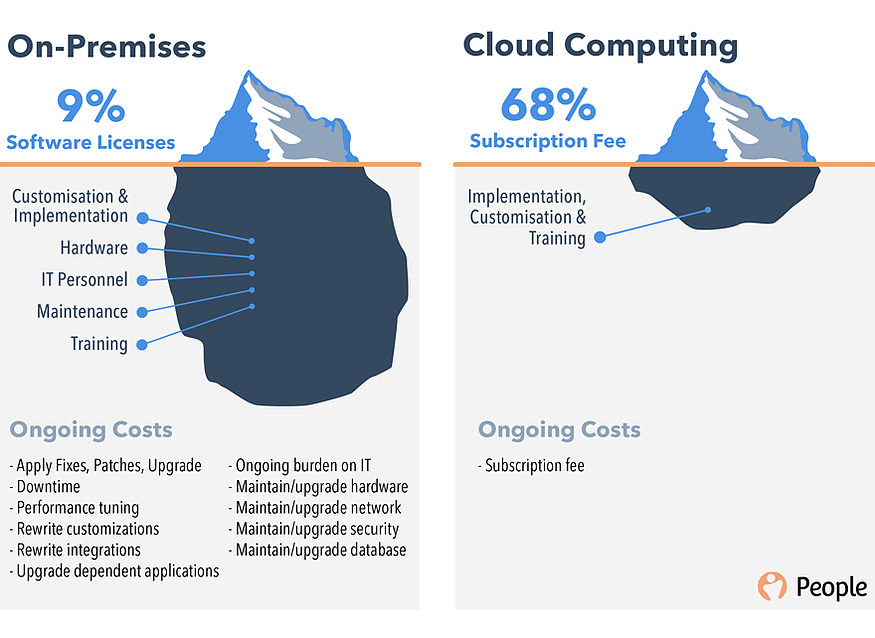Cloud-based vs On-premise HRMS: The Big Question
by Parth Shah posted on 27th August 2019 299 0
As the Chief Technologist of a pharmaceutical company, Rohit Aggarwal was given the responsibility to usher the company into enterprise-level human resource management. Up-till now they had been using a custom-made HR solution that was developed and deployed by a local software company in the mid‐2000s, but now the software could no longer accommodate the rapid expansion the company was going through.
Rohit believed that the future of software and hardware lied in cloud-based solutions. And why shouldn't he? The concept of cloud-based applications no longer remains alien even to common folks. From the mundane task of using Gmail to storing your files in a cloud-based storage solution such as Dropbox and Google Drive, or project management using Slack, cloud-based solutions have become an integral part of our day-to-day life.

However, cloud, like any other big technological advances, carries advantages as well as drawbacks and sometimes keeping systems on-premise can still be the right option. And Hence, before taking the big leap, Rohit wanted to make a strong case for his choice and for this, he did some research & came up with the 5 important parameters that needed to be assessed.
5 Factors to be considered before making the right decision:
1. Cost Implication
The SaaS-based model allows you to start using even the most advanced HRMS solution without an overwhelming investment. One doesn't have to buy hardware or expensive software application and can simply purchase a small subscription and start using the solution.
In the case of on-premise software, the initial set up fee is going to be much higher. But there are no subscription fees involved once you have purchased the licenses. So in that respect, an on-premise solution works out more cost-effective.
However, this isn't where it ends. An on-premise HR solution comes with a huge load of hidden costs that don't show up on the paper. A good way to look at this is by using the ‘iceberg’ analogy which was well explained in an article by peoplehr.

While the initial set-up cost is significantly higher in case of a cloud-based HRMS, the hidden/ongoing costs are much higher in the case of an on-premise solution in the long run. This was an eye-opener for Rohit, as he sat down and calculated the overall cost of implementation on a spreadsheet.
2. Implication Size of the Business, Locations, Business Type
I think this trio plays a major role in defining whether to choose for an on-premise or a cloud-based HR solution. For any organization, which has more than one location, it is far better to choose a cloud solution in order to ensure seamless integration between the locations.
Size of the Organization - For bigger organizations with huge employee base, an on-premise HR software works out well but with necessary IT infrastructure in place, which we will discuss further.

Nature of the Business - Thirdly, If the business has more sales or on-field employees, it is important to note that an app that can capture GPS-based attendance for these employees along with other HR functionalities is of utmost importance. A fully functional App not only requires an IT infrastructure in place but also a team that is working round-the-clock behind it.
3. Functionality, Scalability, Upgrades
Customization - Many CIOs and CEOs prefer on-premise installations because they believe that they have better control over the data and better control on customization features. However, it completely depends on the vendor you select. Cloud-based HRMS comes with more streamlined processes and hence, it is less customizable.
Scalability - If you are a growing organization, most cloud-based solution providers let you change your subscription in real time and you can immediately and gradually keep adding more number of employees to the system without having to upgrade your existing IT set up as it has almost zero dependability on it.
Upgrades - With a cloud-based system, you use the latest version of the software all the time. When the vendor installs upgrades and patches, these upgrades are implemented across-the-board, for all users without any hassle.
4. Security
Security and Data privacy are major factors every organization takes into consideration while making this decision. On-premise software gives complete assurance with that regards as the data is stored in-house with restricted access for an outside entity.
It is important, however, with a SaaS provider, that you must be comfortable trusting a third party vendor handling and keeping your data safe and secured. Despite the fact that a SaaS vendor is likely to have superior security & contingency measures, it can still be a big mental barrier to come to terms with. Getting an NDA (Non-Disclosure Agreement) signed is an ideal way to go about, which most vendors should also be comfortable with.
These days, Most of the software service providers, due to economies of scale, can easily use state-of-the-art security to ensure the safety and security of your data.

5. IT Infrastructure & Team
As you purchase the license of an on-premise HRMS application from the vendor, the entire solution is installed on your local machines ∓ server. The good part about this is, all your data is stored in-house with restricted access to third parties.
Many organizations believe that the cost of setting up IT infrastructure is just a one-time investment. However, what they miss out is that it requires talent and recurring capital to keep it running and fully functional. Hence, to ensure a smooth deployment and the functioning of your HRMS solution you will need to rely on an experienced and knowledgeable IT team.
Even when the IT team has installed and set up the entire installation, one needs ongoing support to install patches and upgrades, for user management and for safety and security of your HRMS infrastructure.

A cloud-based system resides on a remote server, mostly provided by a vendor. Since you don't have to deploy the entire system on-premise, there is no hardware and software cost and hence, no need to maintain the setup.
Concluding remarks
1. If cost is a major factor in deciding which solution to go ahead with, whether in long term or short term, SaaS is a great option.
2. If you are already equipped with a fully operational IT-set up with a good back-up of IT team, you can go ahead with an on-premise solution. However, ensure the credibility is high and it is meeting all your business needs (as discussed in point number 2)
3. If you have existing IT infrastructure but they are not well maintained and backed with good IT talent, please do not fall prey to an on-premise HRMS solution (As it will just backfire to you sooner or later)
4. If data and its security are of utmost importance to you, investing in a good on-premise solution makes more sense. Though it might reassure you to know that more and more data-critical organizations like banks are entrusting SaaS providers with their sensitive data.
5. If you have on-field workforces such as sales, marketing, service force or on-site workers, think of a solution that can provide you with app-based and location-based tagging and other features that become part of an employee self-service such as leave requests, etc.
6. If you want to get started as fast as possible, start with a cloud-based solution that suffices your urgent needs and then gradually add on features and modules as required.
Hope the above points were meaningful and can help you in making the right choice, whether you want to save costs or you are looking for a solution that takes care of itself while you simply leverage its features. Feel free to add a comment below if you need any further clarity.
